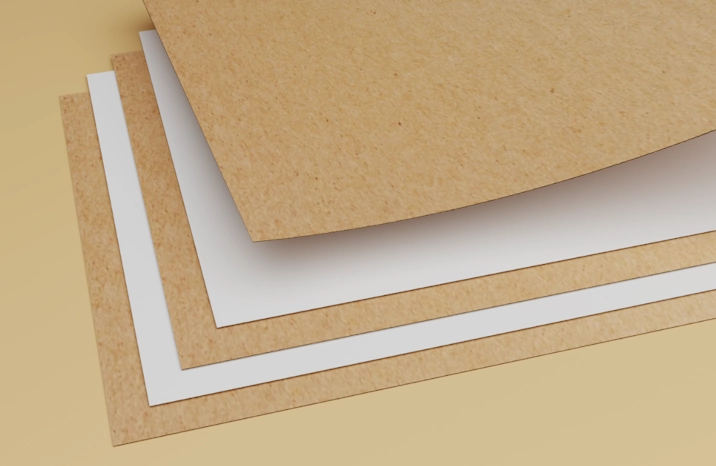Paperboard is a thick, durable, and strong type of paper that is commonly used in packaging. It is easy to fold and has a great surface for printing. It is thicker than regular paper, which is mostly used for writing and printing. Paperboard thickness is usually 0.3 mm to 1.0 mm, that is about 12 to 24 points (with 1 point equal to 0.001 inches).
Paperboard is mostly used to manufacture folding cartons for packing lightweight items.
How is paperboard made?
Paperboard is produced by turning wood pulp or recycled paper into thick sheets through the following steps:
Step 1. Collecting Raw Materials:
Paperboard is made from wood pulp, usually from softwood trees like pine or fir, which provide strong fibers. Recycled paper can also be used to make eco-friendly paperboard.
Step 2. Making the Pulp:
There are two common methods to turn wood into pulp:
- Mechanical pulping: This process grinds raw wood into pulp while producing most of the fibers. It is fast and creates a rougher pulp.
- Chemical pulping: The Kraft process uses chemicals like sodium hydroxide and sodium sulfide to break down wood chips into individual cellulose fibers. This creates a strong pulp, which is then processed further to make paperboard with the needed thickness and strength.
Step 3. Paperboard Formation:
The wet pulp is mixed with water and poured onto a large screen. It spreads into thin layers as the water drains out. More layers can be added to reach the needed thickness.
Step 4. Pressing and Drying:
The wet sheets go through rollers to squeeze out extra water and make the fibers stick together. Then, they are dried using heated cylinders or rollers to remove all moisture.
Step 5. Adding a Coating:
For better printing, moisture resistance, and added strength, paperboard can be coated with clay, polythene, or other materials.
Step 6. Cutting and Finishing:
When the paperboard is dry and sturdy. It can be shaped or folded, and finishing touches like die cutting, creasing, or embossing may be added to prepare it for packaging or other uses.
Types of Paperboard
Here are some common types of paperboard:
- Solid Bleached Sulfate (SBS): Made from pure white bleached virgin fibers. It’s smooth and great for printing. Often used for cosmetics, medicine, and food packaging.
- Coated Unbleached Kraft (CUK): Made from unbleached kraft fiber, which gives it a natural brown colour. It is strong and perfect for beverage packaging and heavier products.
- Folding Boxboard (FBB): Made with layers of recycled fibers and has a smooth surface for printing. Commonly used for retail boxes and electronics.
- White-lined Chipboard (WLC): Made from recycled paper with a white top layer, it is affordable than others. Mostly used for high-end products like food boxes and tissue boxes.
What are the customization options for paperboard packaging?
Explore the endless customization options with paperboard packaging to make your product stand out.
- Custom Dimensions: With die-cutting, you can create custom shapes, styles, and secure closures, giving your packaging a unique touch that fits your product perfectly.
- Printing and Branding: Paperboard can be easily printed on both sides, allowing you to showcase your brand’s logo, designs, and taglines clearly and attractively.
- Finishing Touches: You can add special finishes to enhance the look of your packaging, including lamination, varnish, embossing, debossing, and foil stamping to make your boxes stand out.
- Inserts and Dividers: Paperboard can also be used to create custom inserts and dividers inside your boxes, helping to protect and organize products to ensure safe delivery.
Why is paperboard the ideal choice for custom packaging?
Consider the following factors of paperboard for the custom box packaging:
- Product Weight and Protection Needs: Paperboard is strong enough to protect your products while being lightweight, making it perfect for both fragile and heavier items.
- Branding: If you want your packaging to reflect your brand’s personality, paperboard is a great choice as it can be easily printed on and customized to match your brand’s look.
- Budget-Friendly: Paperboard is cost-effective, offering high quality and customization options, making it an ideal choice for businesses on a budget.
- Biodegradable Choice: If you’re aiming for eco-friendly packaging, paperboard is a good choice as it can be made from recycled materials and is easily recyclable.
- Industry-Specific Needs: Paperboard can be tailored to meet specific needs in various industries, whether it’s food-safe paperboard for the food industry or sturdy packaging for retail items.
Which industries use paperboard packaging?
Paperboard is a multipurpose material that’s great for many types of custom boxes. It’s strong, lightweight, and easy to print on, making it a popular choice for various industries.
- Retail: Paperboard is often used in the retail industry for items like cookies, dispenser packs, and bagged goods. It allows for bright colors and eye-catching designs that attract customers.
- Food: Food-safe paperboard is great for packing snacks, cereals, frozen foods, and drinks. It keeps food fresh and safe, and it’s easy to recycle. It’s perfect for burger boxes, takeaway containers, and drink packaging.
- Toy: Paperboard is also used for toy packaging to keep toys safe and make them look fun and colorful. It’s great for packaging things like Barbies, action figures, and fidget toys.
- Cosmetic: Paperboard is a popular choice for cosmetic packaging because it’s light, strong, and easy to customize. It’s perfect for items like lipsticks, mascaras, and eyelashes.
